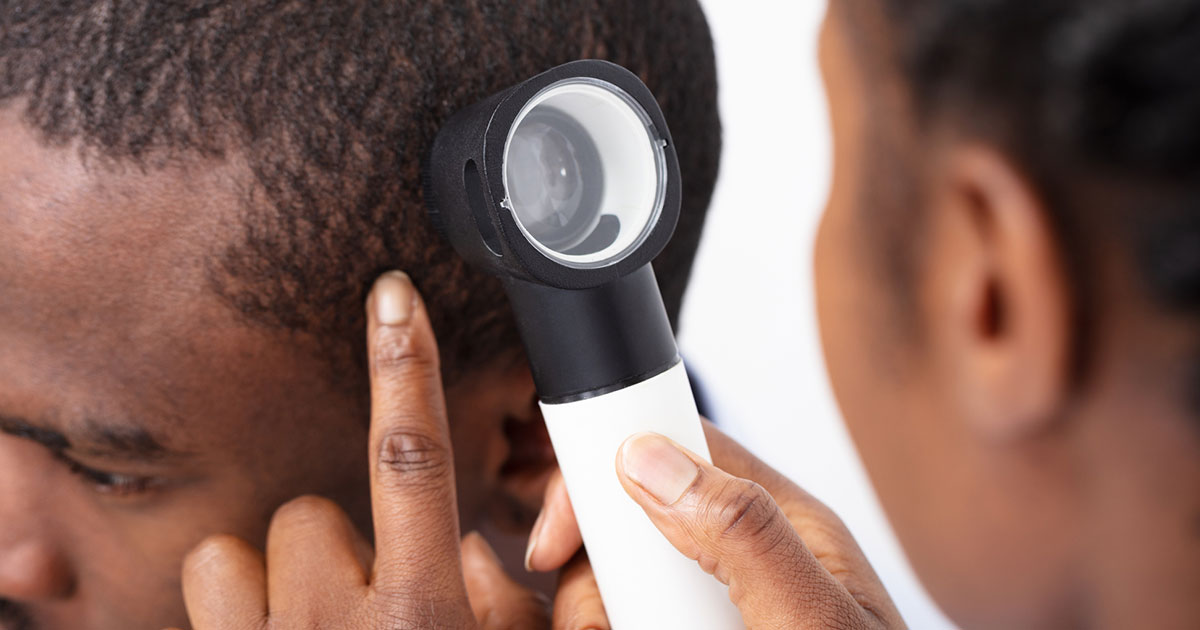
Skin cancer is the most common cancer in the United States, with an estimated one in five Americans developing the disease during his or her lifetime. It’s important to know that skin cancer may affect anyone, regardless of skin color. In fact, African Americans are more likely to be diagnosed with melanoma, among the most dangerous types of skin cancer, at a later stage, when it’s more difficult to treat. High risk factors for all skin types include:
- Skin that freckles or burns easily
- Exposure to ultraviolet (UV) light—both from the sun and tanning beds
- Early UV exposure—especially one or more blistering sunburns as a child
- Experiencing five or more blistering sunburns between ages 15 and 20
Considering these factors, you may think skin cancer usually appears on areas of your body exposed to the sun. This is often true of two types of skin cancer: basal cell and squamous cell carcinomas. These skin cancers are commonly found on the face, head and neck (although they may also appear on other parts of the body).
“Basal cell skin cancers are less likely to metastasize and tend to appear as flesh-colored papules (raised areas of skin) on the face. Squamous cell skin cancers may occur anywhere on the body and show up in a variety of ways,” says Laura Farrington, DO, Medical Oncologist at City of Hope Chicago. “They tend to be slower growing and have less metastatic potential than melanomas.”
Melanoma is not as common as basal or squamous cell, but it’s more likely to grow and spread. Melanoma is also linked to UV exposure but may also appear on the skin suddenly as a new growth or develop on an existing mole in places that aren’t exposed to the sun.
To protect yourself, it’s important to get yearly skin exams by a physician. You should also perform monthly self-exams, noting anything suspicious. Two warning signs or symptoms of skin cancer include:
- Any change in size, color, shape or texture of a mole or other skin growth
- An open or inflamed skin wound that won't heal
For hard-to-see body parts, try using a hand mirror or ask your loved ones for help. Also, be sure to check these commonly overlooked spots where skin cancer can hide:
The feet
The tops of your feet may get a lot of sun exposure and be susceptible to basal cell or squamous cell cancers, especially if you often wear sandals or flip flops. But melanoma may also develop on the bottoms of your feet, between your toes and under your toenails.
Legendary reggae artist Bob Marley died at age 36 of a rare, fast-growing skin cancer called acral lentiginous melanoma (ALM) that started under his toenail. ALM is the most common type of melanoma in people with dark skin and those of Asian descent. However, it may occur in people of all skin colors.
The scalp
“The scalp is a common site for melanomas,” Dr. Farrington says. It’s estimated that about 6 percent of melanoma patients have developed malignancies on their scalp or neck, and both sites are associated with worse outcomes compared to melanoma on other areas of the body—perhaps because diagnosis tends to be delayed.
Since it’s difficult to check your own scalp, be sure your physician examines that area during your annual physical. “It’s also easy to ask your hairdresser to do a quick scalp check during a haircut,” Dr. Farrington adds.
Behind the ears
Another common spot skin cancer can go undetected is on the backs of your ears, especially if the spot is relatively smooth and small. But melanoma on the ear may invade areas close to the cartilage, raising the risk of the cancer penetrating a nerve or blood vessel, and potentially, spreading to the lymph nodes. When cancer spreads to lymph nodes, surgery and radiation therapy and/or chemotherapy may be necessary to treat it.
The pubic and pelvic areas
It’s important to know that melanoma may occur in places rarely if ever touched by sunlight. The pubic area is a common place for moles to show up, even in people without a lot of moles. As with any moles, these should be checked regularly for changes.
“Any new skin lesion or one that bleeds easily should be evaluated for skin cancer by a physician,” Dr. Farrington says. “It’s also important to have regular gynecologic exams, because even though this area does not have sun exposure, melanoma may still occur.”
Under the nails
Melanoma under the nails is rare, but it does occur. The main symptom is a brown-black vertical stripe on the nail. A dark line extending from the nail to the cuticle and nearby skin, which is called a Hutchinson's sign, should also be checked out.
To help protect yourself and your loved ones from skin cancer, remember these sun-safety tips:
Wear broad-spectrum sunblock with a sun protection factor (SPF) of 30 or higher. Reapply every two hours, as all sunscreens deteriorate after some time. If you’re swimming or sweating, reapply more often. Don’t forget your lips, eyelids, between your fingers and toes and behind your ears.
Help your kids apply and reapply sunblock, “because even one sunburn as a child can increase the risk for skin cancer,” Dr. Farrington says.
Avoid the sun between the hours of 10 a.m. and 4 p.m., when rays are strongest.
Avoid tanning booths and beds that use concentrated UV light. The risk of skin cancer is so great that some states have banned or limited their use.
Wear protective clothing including wide-brim hats, UV-blocking sunglasses (both UVA and UVB), and long-sleeve shirts and pants.
Examine your skin monthly and get checked by a dermatologist annually.
Know the ABCDEs of skin cancer:
- Asymmetry: Half the mole is different than the other half.
- Border: Edges are notched, uneven or blurred.
- Color: The mole is uneven in color, or has shades of brown, tan and black.
- Diameter: Diameter is greater than 6 mm, or the size of a pencil eraser.
- Elevation and evolution: The mole is raised or changes over time.


